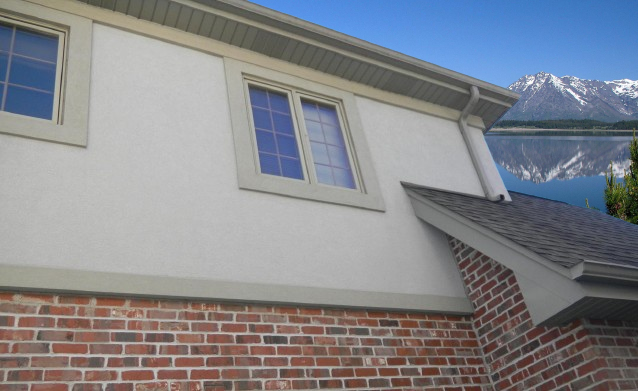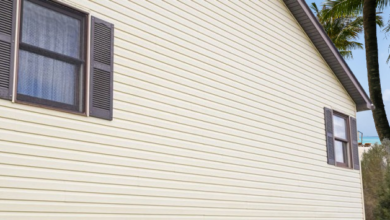DEFS vs. EIFS Exterior Cladding

One of the many things you have to think about as a soon-to-be property owner during construction is the kind of exterior cladding that you should use. Aesthetics is usually given priority by most people.
However, that isn’t always sufficient because the choice of exterior cladding will affect the functionality and even the longevity of the building. Currently, two of the most widely used external cladding options available are DEFS and EIFS.
If you’re having trouble deciding between the two, I’ll be comparing the advantages and disadvantages of each in this DEFS vs. EIFS guide to help you make a wise decision.
Describe DEFS. (The Lightest External Cladding System At The Lowest Cost)
Direct Applied Exterior Finishing System, or DEFS for short, is a relatively new type of cladding system made of polymer-based products.
As the name implies, DEFS is directly applied to cement board or DensGlass sheathing boards. There is no insulation on DEFS. As such, the primary sources of insulation are the sheathing boards to which they are applied.
The majority of people are unaware that DEFS was released into the market to rival wood siding and other exterior wall claddings.
This system is frequently fairly basic and brittle. For this reason, it is uncommon in the majority of the nation. DEFS, however, is incredibly economical.
Essential Elements Of An Exterior Finishing System Applied Directly
- It comes in a variety of colors: DEFS is available in a variety of colors and textures, which can greatly enhance the external appearance of your home.
- It resists cracking: DEFS, a novel and sophisticated wall cladding, is designed to withstand cracking.
- Weather-resistant: DEFS shields your structure from moisture, sunlight, and rain.
- Easy to Install: The Direct Applied Exterior Finishing System’s ability to be applied directly to substrates like cement boards is another distinctive feature. Because of this, the application procedure is rather simple.
Benefits Of DEFS
- The price is reasonable
- The aesthetic appeal is pleasing.
- It needs little upkeep.
- It will keep moisture out of your building.
- There are numerous design options available.
Drawbacks To DEFS
- The primary flaw in DEFS is its lack of insulation.
- It is brittle.
EIFS: What Is It? (The Highest Energy-Saving External Cladding Solution)
Had this been a popularity contest, I would have announced EIFS as the winner right at the start of the piece. Building cladding of this kind is a popular option for both residential and commercial buildings.
Its inception dates back to World War II, when it was employed to restore buildings damaged by bombs. Over time, though, regular construction was also included in its application.
EIFS stands for Exterior Insulation and Finish Systems, for those who are unaware. It consists of a thin layer of fiberglass covered in cementitious material, which is layered on top of rigid foam insulation fastened to sheathing such as gypsum board or cement.
To stop moisture from penetrating an EIFS system, a water barrier must be used in between the foam insulation and sheathing board.
Prior to delving into the salient characteristics, it is imperative to acknowledge that Exterior Insulation and Finish Systems are universally applicable, regardless of the local climate or environmental circumstances.
Important Aspects Of Finish Systems And External Insulation
- This system includes an insulating board. One of the special features of EIFS is the foam board that provides insulation. You will thus benefit from increased energy efficiency with this system.
- It is available in an array of colors and textures. If aesthetics is a concern for you, EIFS has you covered. You can experiment with a variety of hues and textures, as well as replicate building claddings like brick, stone, or stucco.
- Extremely light-weight. EIFS is much lighter than the majority of exterior claddings you’ll encounter, which reduces structural load.
- Superior moisture management is a claim made by EIFS. Recall that I mentioned that an EIFS needs to have a water barrier. There are other moisture barriers in this setup in addition to that one. Additionally, a drainage plane is included to guarantee that no moisture penetrates.
Benefits Of EIFS
- It uses a lot of energy.
- It is not easily cracked.
- It has a variety of hues and textures.
- If installed correctly, there is a guarantee that there won’t be any water damage.
Drawbacks of EIFS
- Because of the intricate setup of EIFS, maintenance and repairs can be very time-consuming.
- Appropriate installation is also required; otherwise, moisture will easily seep through.
What Distinguishes DEFS From EIFS?
You have been waiting for this moment, I know. Let’s get right to what DEFS and EIFS differ from one another.
- Compared to DEFS, EIFS Provides Better Insulation
Sheathing board serves as the primary source of insulation in a Direct Applied Exterior Finishing System. Furthermore, these materials aren’t intended to provide a lot of insulation, as you may already be aware.
Regarding EIFS, the primary function of rigid foam board is to act as insulation. Therefore, you can be sure that this system will provide you with improved insulation, which will increase the energy efficiency of your building.
- EIFS Is Better Than DEFS at Managing Moisture
As previously stated, DEFS is designed to stop moisture from getting inside. Nevertheless, the brand and installation quality have an impact on this feature’s efficacy.
On the other hand, EIFS makes use of the best techniques for managing moisture, like putting in a water barrier and drain plane. These two are far more effective at preventing moisture from entering your building.
- EIFS Is More Versatile in Terms of Aesthetics Than DEFS
Yes, DEFS is available in a variety of hues and textures.
EIFS, on the other hand, is better at imitating external building claddings like brick or stone. When it comes to aesthetics, EIFS gives you a lot more flexibility than DEFS.
- DEFS Is Not As Heavy As EIFS
It makes sense that DEFS is substantially lighter than its counterpart because it is made of fewer materials.
EIFS, however, weighs a lot more than DEFS. Therefore, if you decide to go with this course of action, be sure to make the necessary changes to your structure.
- Installing DEFS Is Easier Than EIFS
DEFS are much simpler to install since they are applied directly to the substrate or sheathing. This is a project you can handle on your own if you enjoy do-it-yourself projects.
The installation procedure for EIFS is a little more difficult. Recall that there are numerous product layers that need to be installed. Therefore, it would be best to have a licensed and experienced contractor handle this project.
- Repairing DEFS Is Easier Than EIFS
Given their simplicity, DEFS are far simpler to fix if they are damaged. The repairs for EIFS are more difficult.
What Similarities There Are Between Them?
In addition to the previously mentioned differences, these two systems have many things in common. These things include:
- They’re Both Materials for External Cladding
Both EIFS and DEFS are utilized in exterior cladding systems to enhance the building’s appearance and provide weather protection.
- Neither requires a lot of upkeep.
Maintenance should be the least of your worries, regardless of whether you select DEFS or EIFS. All these cladding systems require are routine maintenance and cleaning.
- They Are Both Used On A Substrate
Whichever system you choose, you’ll need a suitable substrate, like gypsum board or cement. These are required.
- Both Possess Certain Crack-Resistance Qualities
Both systems have some degree of crack resistance, despite the fact that DEFS is more delicate. That makes a big difference in how long it lasts.
And why should someone select DEFS?
Following a thorough analysis of the Direct Applied Exterior Finishing System and a comparison with the EIFS, the following scenarios highlight the ways in which builders, designers, and prospective property owners can gain more from DEFS:
- If the building is situated in an area with a moderate climate: DEFS can function flawlessly as long as your area doesn’t see harsh weather or excessive temperature swings.
- If you’re searching for lightweight cladding: DEFS is a great substitute for heavy cladding in the event that your structure cannot support it.
- Individuals seeking an easy-to-install system: If skilled labor is unavailable, you can use DEFS instead because it is simple to install.
- Budgetary restrictions: DEFS offers cost-effective advantages if you’re working within a limited budget.
And why should someone select EIFS?
EIFS has many uses, which is why it is so well-liked. The following situations warrant considering EIFS over DEFS:
- You want increased energy efficiency. EIFS has insulation, but DEFS does not. Therefore, the latter will help you save money on your electricity bills.
- There are numerous designs to select from because EIFS is more aesthetically pleasing. There are numerous hues, finishes, and textures to select from.
- You reside in a place where it rains a lot. How much rain falls in your area? Compared to DEFS, EIFS has superior moisture management. Therefore, the former will guarantee less water intrusion.
- You live in an urban environment with a lot of noise. EIFS also offers some sound insulation, which is helpful if you live in a noisy place.
- You’re remodeling a building. If you’re remodeling a building, EIFS can add insulation and seal leaks while also improving the building’s appearance.

